Björk
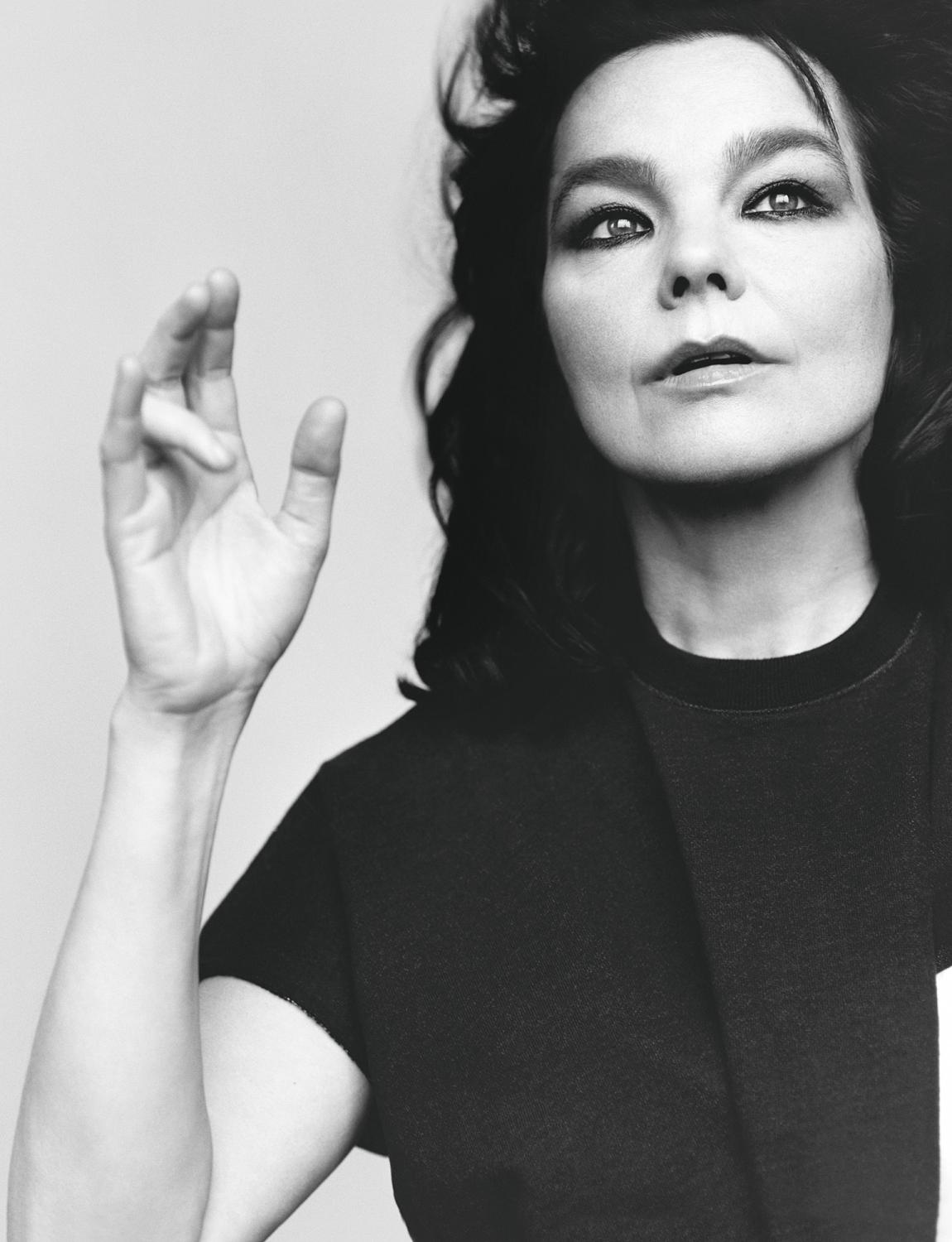
Portraits by Alasdair McLellan
Styling by Jonathan Kaye
Issue n° 11, Spring & Summer 2015
Björk Guðmundsdóttir’s always been full of surprises — musically, visually, even romantically (she dated Tricky and Goldie). At 49, she’s still on the road to revelation. Her gorgeous new album, leaked in January, drips with pain and self-investigation following her recent heart-breaking uncoupling, while a major exhibition opening at New York’s Museum of Modern Art in March promises to blow our socks off with more-than-state-of-the-art sonic installations and galleries filled with glittering ideas.
Björk’s modest stucco house in Reykjavik doesn’t look like much from the outside, but inside a world of treasures awaits. A garage is spray-painted with bright characters from the Land of Ooo, normally viewed only in the confines of the television cartoon Adventure Time. The kitchen wallpaper is made of images of copper-coloured braids. A small Remedios Varo print of a woman catching nothing in a net hangs near the light switch. In the boot room, shoes in every colour of the rainbow are lined up underneath hooks from which hang masses of bright coats. A large fluorescent cage for her daughter’s hamster sits on a chair. “The hamster got an eye infection and we’ve been putting medicine in her eye in the evenings,” says Björk. “It’s starting to get a little better.”
Today, late on a winter afternoon, Björk Guðmundsdóttir appears as a teeny earth goddess, standing 163cm tall. The dark, thin features of her face are lovely, expressing themselves brightly under thick black bangs. She greets me in a form-fitting white Junya Watanabe dress with black piping topped with a sheepskin bolero jacket. A few minutes later, though, she disappears upstairs and then returns a different size, courtesy of white platform shoes with many inches of heel that she’s chosen to complement the dress. “I find something I like, and then I wear it for a couple weeks at a time,” she says of her outfit, “but I’m rubbish at keeping things nice. I’ve started to give back some of my clothes, like the Alexander McQueens, for their archives, so they can just take care of them.”
Björk is one of the most iconoclastic popular artists today, in fashion and in music, focused always on metamorphosis and forward movement. For her, fashion isn’t mere surface styling – her relationships with designers are close and meaningful. In 1994 she walked in Hussein Chalayan’s show and then wore his airmail jacket on the cover of her album Post the following year. McQueen was directly involved in the artwork for her 1997 album Homogenic; she performed at his memorial at London’s St Paul’s Cathedral wearing wooden wings. Musically she’s done it all – trip-hop, four-to-the-floor beats, jazz, complex string and synthesiser arrangements – and she’s used her main instrument, her weird, supernatural voice, to transform herself into many different women, sometimes innocent, or neurotic, or gripped by ecstasy and abandon, but always sounding like she holds the key to the secrets of the world. Vulnicura, her latest album – and a critical ingredient in a mid-career retrospective that opens at New York’s Museum of Modern Art in March – is a “very different poem”, as she puts it. “To be honest,” she says, “out of all the music that I’ve done in my life, if there was ever an album I could not control, it was this one.”
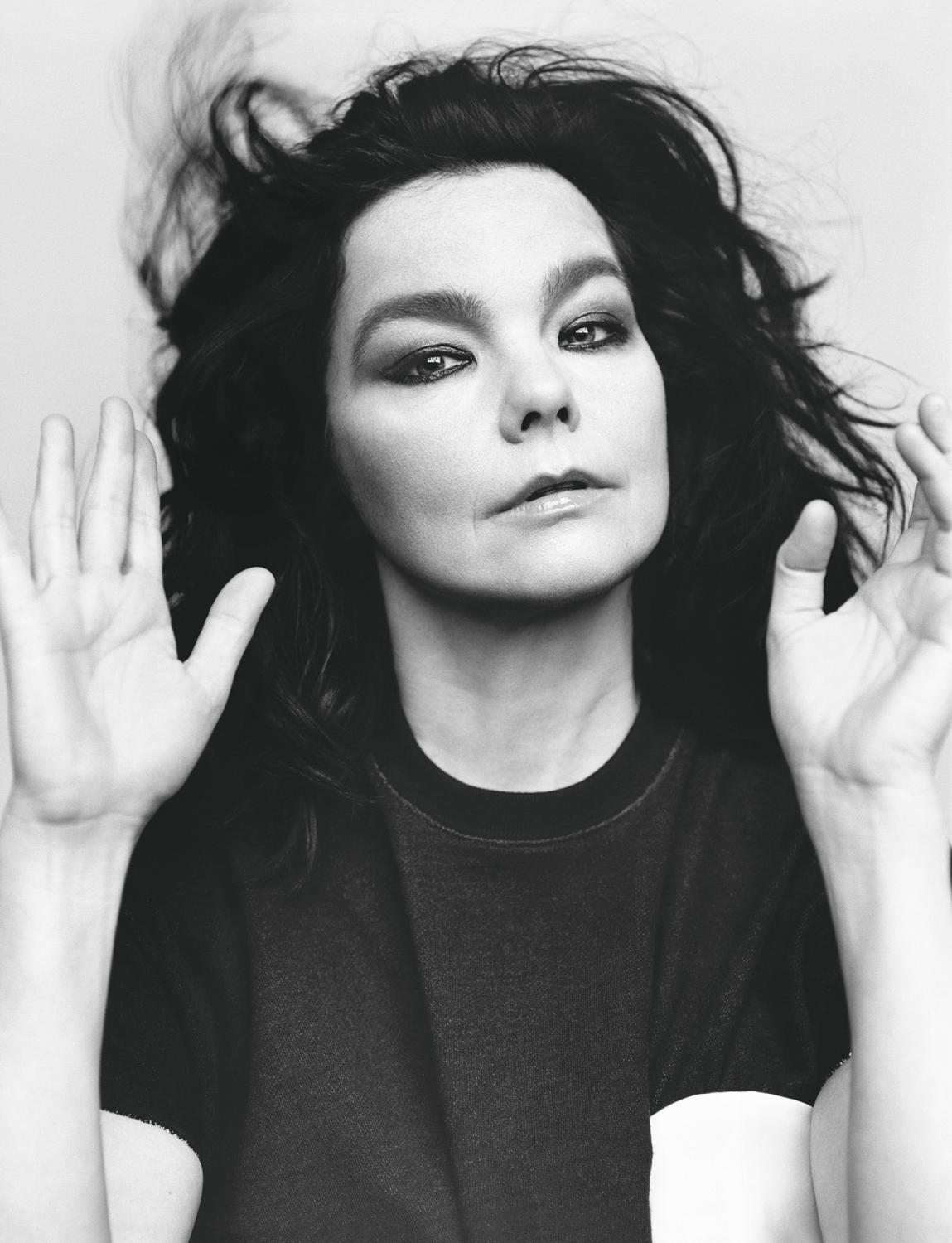
Björk admits she struggles to look after her outlandish outfits. Here, and in the opening and final images, she wears a simple black cotton crew-neck dress by MARC BY MARC JACOBS.
Today is the last day of mixing Vulnicura. In just a few weeks, it will have leaked on the Internet far ahead of its scheduled launch. When that happened Björk reacted to the news optimistically, unlike most artists. “I think that this time the leak worked for me,” she tells me later, mentioning that she often finds the liminal time between finishing an album and its release “unbearable” and believes “the dinosaurs of the record industry” should remove this gap. “Tons of times it has worked for or against,” she continues, referring to hacking. “The trick is trying to align oneself with the energy at any given time.”
Björk sits at a knotted wood table in her petite but comfortable living room with a fire burning and the lights low. The days are short in Iceland now, and the sun doesn’t rise until about 11am, but she woke at 7.30 this morning to get her daughter ready for school. Then she performed kundalini yoga exercises, which she tries to do at least a few times a week. “Kundalini is very helpful for my voice, because it involves a lot of breathing,” she says. “I turn the sound off on a yoga DVD and put some amazing music on very loud.” She also drank some coffee. “I don’t have coffee every day,” she says. “I can’t do it every day, so I usually drink it every third day. My body just can’t take it. But every three years or so, when I’m mixing an album, I find I drink coffee all the time.”
In a couple of hours, she’ll jump in her car to meet Alejandro Ghersi at a local recording studio. The young Venezuelan producer, known as Arca, made his name last year with the FKA Twigs album and Xen, his own record. “It’s almost like a tide – at the beginning of every album, I become very introverted, as part of a natural process,” Björk says. “I just write and write and write.” But now, as Vulnicura is getting its final touches, she’s entering the phase when “I become more extroverted, also naturally.” And then “one or two appearances on TV, and then you go whoosh.”
It’s not that much of a surprise to see Björk, who’s always brandished her Icelandic pride, in this setting. Despite her peripatetic rock star lifestyle, she still spends as much time in her home country as possible. But it is a surprise to see her alone. Her 13-year partnership with Matthew Barney, the contemporary fine artist known for his surrealist, body-centric films and sculptures, is over. From its early-noughties beginning, the relationship always seemed like the world’s most exquisite match: not a phony art/music/fashion crossover but a pairing in which each was fully dedicated to his or her own art form and coexisted on an equal, separate plane.
As we talk today, it’s clear that Björk is still working through the process of separation. On one hand, she says, “It’s been so unbelievably painful to go through this – the most painful thing I’ve ever gone through in my life.” And on the other, she’s always been able to find the humour in a terrible situation. “I’m annoyingly predictable in some ways,” she says, sipping a cup of tea. “I’m the textbook example of a divorcee. My friend gave me a self-help book that sold a scrillion copies, and it was amazing to find that what I was going through was exactly what everyone goes through. ‘OK, yes, after this many months you feel like this, after that many months you feel like that.’ What actually helps you get through it are other people who have gone through it, who are six months further than you or a year further than you, and they can say, ‘Hi, I’m still alive.’”
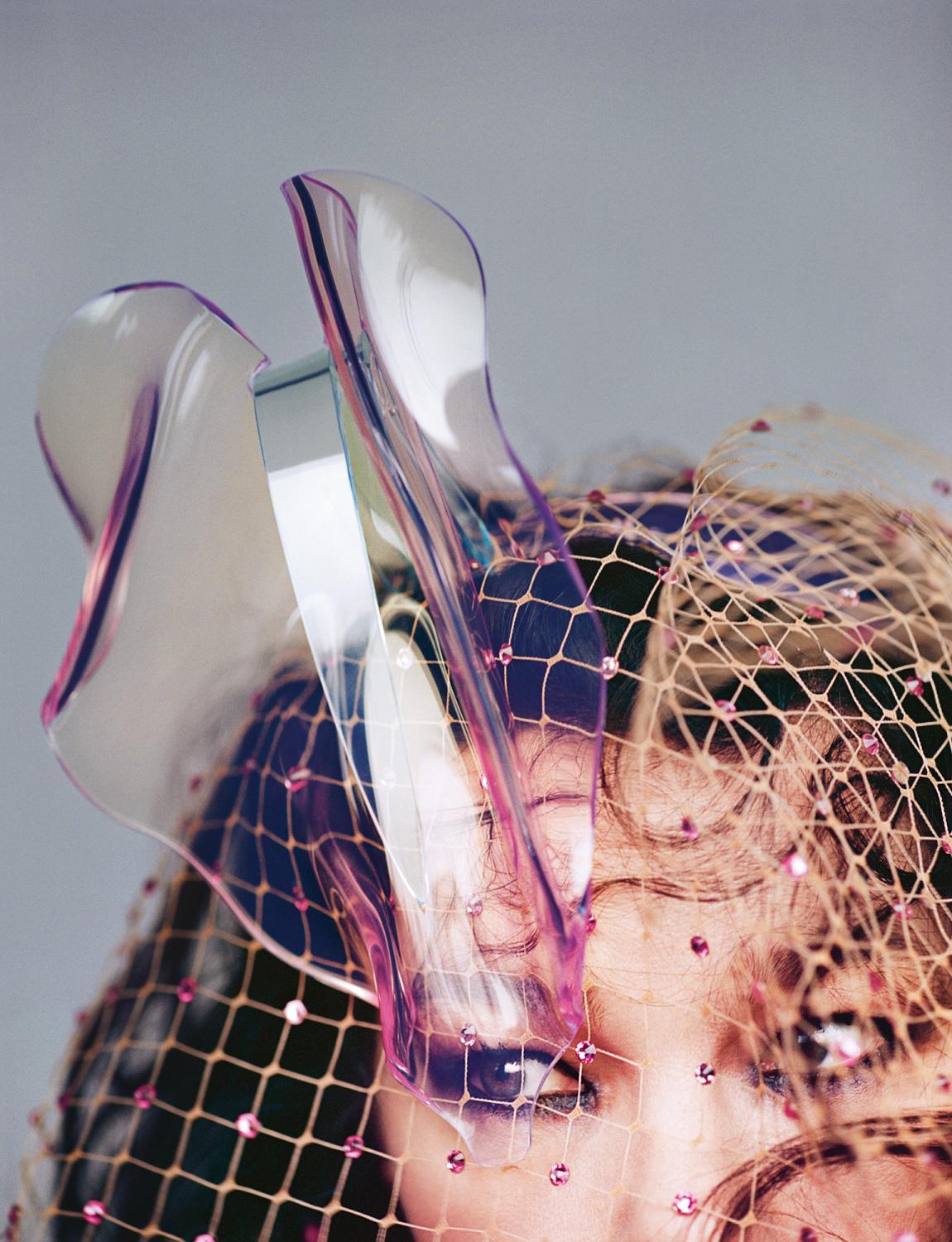
Björk wears a lustrous plexiglass and sequinned-net hat by STEPHEN JONES for EMANUEL UNGARO.
What to do with the pain? Clearly, because she’s Björk, she was going to compose songs about it, during a series of easy nature walks (“I’m not doing crazy stunts – I’m a singer, so I want to breathe and sing, not climb up hills,” she clarifies). She says she “could not control” Vulnicura’s content – gorgeous, layered songs that Adele lovers are likely to embrace; contemporary classical music paired with singer-song-writer lyrics about love. The songs, which mostly trace the disintegration of the relationship, came quickly. “The nature of a heartbreak album is that the lyrics are almost spoken,” she says. “It’s very conversational. It comes out of you at a very emergency-like level.”
Most of the vocals for Vulnicura were recorded at home in Reykjavik. She also owns a small cabin on a hill by Lake Þingvallavatn that she renovated – “it always surprises me that you go over one valley and mountain and you leave everything behind” – and where she’s had many inspirational moments. Antony Hegarty, the English singer/composer/artist who collaborated with her on the album, says he first met her there. “We sat together and sang in the dark,” he says. “We were kind of searching for a point of connection. We would intone the same note, or slight variations of it, for a long time. The first thing we really did together was sing. It was unusual. The recordings from that night are really precious to me.”
The first phase of composition may have been easy for Björk, but when she finished the songs and sat down to listen to them for the first time, “I was like, ‘Oh my God, I have a breakup album,’” she declares, bringing her hands to her face like Edvard Munch’s “The Scream”. “When that happened, at first, I was really like a grumpy teenager,” she continues, banging the table. “I was like, ‘This is predictable, this is like boring, I’m above this shit – this is not me.’” She even thought about putting other songs on the album to dilute the effect. “It got to a certain point where it was like, ‘OK, should I just mess the songs up?’” she says. “‘What should I do?’ You know?’”
But then, she says, “I was just like, ‘I can’t do it.’ It’s the music snob in me who always wants to be doing cutting-edge, new things that’s kind of appalled that I’m doing a heartbreak album. But the anthropologist in me is like, ‘Let it just be what it is, because it’s the only way I can move on to the next thing in my life.’” She says she just decided to “think to myself: ‘Breathe deeply and trust my editing skills.’ At the time, it was so painful, but I knew that by the time I’d release the album, at least two years would have passed, and then I would have a more sensible head on my shoulders. And I could look at it and release it or not release it, you know.”
She stares into the fire and then casts a bit of sage into it, filling the room with a lovely smell. “I played it to some of my friends – really close friends – though I didn’t play it to that many, to be honest,” she says. And she found out she was wrong about something: “I realised that I was thinking it was 500,000 times more explicit than it actually was,” she says. “I feel pretty good about it now.”
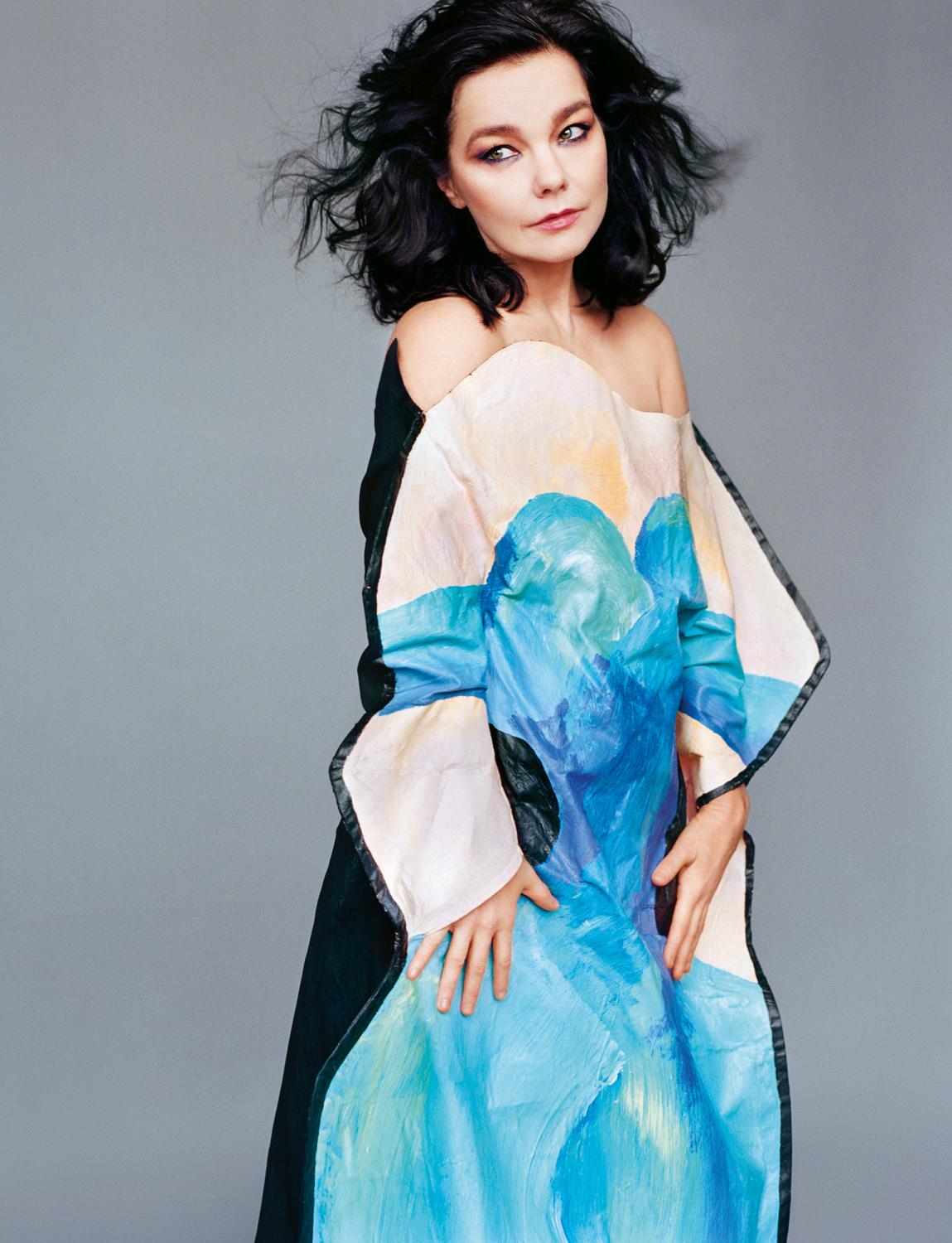
Björk has championed radical fashion throughout her career, both on and off stage, favouring Alexander McQueen, Hussein Chalayan and Bernhard Willhelm, among many others. The designer to have captured her imagination most recently is FIONA O’NEILL. Here, Björk wears a blue-and-pink hand-painted dress by the young Irish Central Saint Martins graduate.
Björk is far more of a rational being than you might expect; she’s deeply analytical (as one would have to be to compose such intricate music) and has a way of speaking and gesturing that sometimes recalls her punk roots and at other times her hippie ones. An intensely social person, she’s always valued her friends deeply, and perhaps at this moment more than ever. She grew up on the outskirts of Reykjavik in a family of craftspeople – “electricians, knitters and hunters” – with a father who would become a union leader and a mother who separated from him when Björk was a year old. “She was one of those ladies from that generation who would have been a housewife working at home, but she couldn’t handle it and divorced my father, not so much to divorce him but to get into the whole thing in the ’60s,” she says.
Björk’s stepfather played guitar in hippie bands, and her childhood was “a little chaotic” but fun. “Our house was like a fairytale house, and we would play in the moss” with other families. “Hippies love kids, so everyone listened to me. If you want to be a koala bear for a week, you can be a koala bear for a week; if you want to write a symphony, you can write a symphony.” She cocks her head and tells a story about how, more recently, someone bought her childhood home, a small wooden house, and then decided to move it to the country as a vacation cabin. “My house is now on the way to the airport, actually, just sitting there way out in the lava,” she says. She sees it when she’s on her way out of town. “It’s so weird. If it was an art piece, no one could have done it better.
A musical prodigy, Björk studied classical flute and piano as a child and recorded her first album at 11. “Especially as a child, I always imagined I would buy a small island in Iceland and just write music and be there with the birds and the ocean and the cliffs and be ecstatic, and I would write music all my life and never care if people would hear it or not,” she says. “I’m aware that that’s very romantic and utopian, OK? And like everyone, I have contrasts in me. There’s another side of me that’s the opposite.”
As a teenager, Björk sang in the cacophonic punk band Kukl with a bunch of guys she’d met at the local record shop. In 1986, some of Kukl’s members formed the Sugarcubes, along with Björk’s first husband, Þór Eldon. She was 20 and had just given birth to her son, Sindri Eldon Þórsson, now 28. “Our song got chosen by Melody Maker as the top single of the week or whatever, which was a very big deal, and we were approached to ask if we wanted to tour,” she says. “And I said, ‘Well, if my son can tour, I’ll do it, or otherwise I’ll stay in Iceland.’ And this is something I didn’t understand until later, because Iceland is something of a matriarchal country – well, not totally, but compared to Western countries we’re at the top of the list – but no one in the band questioned that I was going to bring my son and take a nanny and take that off the fee that the band got. I was chatting about that with some of the Sugarcubes recently, and we laughed about it, like, ‘Whoa, that’s probably some good feminist shit that happened there.’”
“I always get a reflex to rebound and do something different. With the last album everything was pink; now I want everything to be blue.”
The Sugarcubes broke up in 1991 – though they still run a record label and publishing house, Bad Taste, together – and Björk went off on her own with her first album, Debut, two years later. Danceable, funny and lush, it established her as a force in the recording world and, with Michel Gondry’s video for “Human Behavior”, the visual world too. Though sonically diverse, her subsequent albums – Post, Homogenic, Vespertine, the a cappella Médulla, the Timbaland-produced Volta, and Biophilia – all have one thing in common: each is very different to the one that preceded it. Biophilia was challenging to the non-musical ear, built around arresting sounds like those from a Tesla coil; a complex undertaking, it included a set of apps that are now used to teach music and science in Iceland. Vulnicura sits at the other end of the spectrum. “I always get a reflex to rebound and do something different from the previous album,” she says. “Because with the last album everything was pink, now I want everything to be blue.”
When she was younger, Björk liked the pop star lifestyle, and she still loves playing both small, intimate venues and huge festivals “with 50,000 people, and the sun goes down in the middle of your set.” But she got over the red carpet years ago, around the time of the famous swan dress moment at the 2001 Oscars, which she attended in connection with her work in Lars von Trier’s Dancer in the Dark. “It was so obviously a gag – I mean, who would bring six ostrich eggs and leave them, like, on the red carpet in Hollywood and be serious, you know? I think in Europe you have so much experience of public eccentrics that it’s not a big deal. And by the way, I’d worn a dress six months beforehand that was way more crazy for Cannes, and nobody noticed.” In America, awards ceremonies are treated differently. “The red carpet at the Oscars is like coming to a cathedral – a church. So it was sort of like wearing a clown suit in a Catholic church on Easter mass. At the time, I didn’t realise that, but had I known, I probably would not have done what I did. I don’t have that sort of anger, that I want to fuck people up. I’ve got my anger, but Hollywood isn’t where I’m going to try to change the world.”
She laughs. “What’s so interesting is that people in Hollywood thought that I was trying to wear an Armani but just got it wrong. Like I was a naive elf from Iceland that didn’t know how to pick an Armani dress. Uh, hel-lo.”
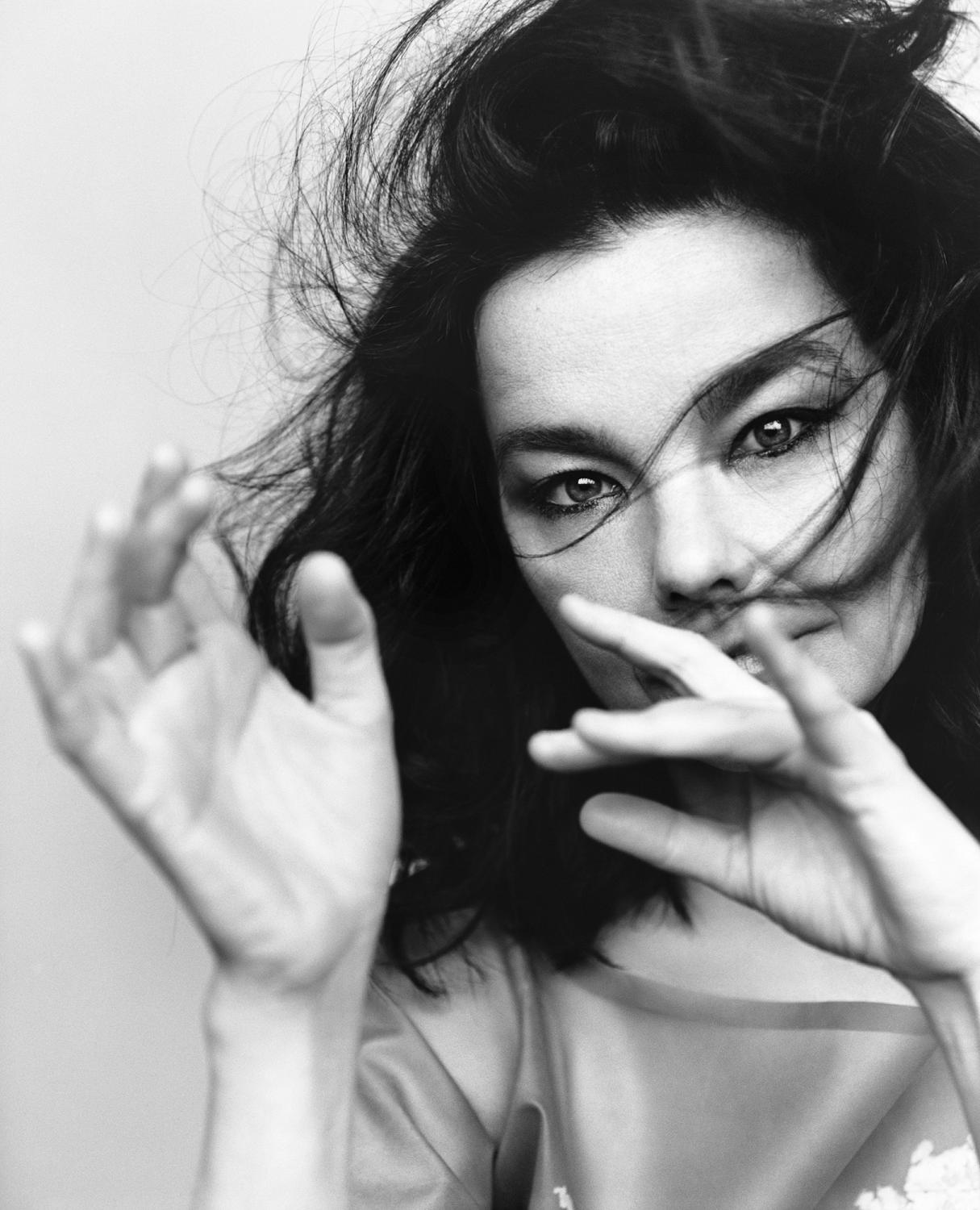
Here, Björk wears a lilac latex T-shirt custom made by LOEWE.
It’s threatening to snow outside, but the fire has made her living room hot, and Björk throws off her bolero jacket, dropping it on a chair. Her assistant, James Merry, a redheaded Brit who used to work for Damien Hirst, pops in to say that it’s almost time for Björk to meet Arca at the recording studio, and I’m invited along. He also has news of a phone meeting scheduled with Klaus Biesenbach, the MoMA curator who’s putting on her show at the museum.
“The first time I invited Björk to do something with me was 15 years ago, but I was just getting to know her,” says Biesenbach, who calls Björk “family”. “I think she needed Biophilia, though, in some ways, because it allowed her to step into the museum and exhibition world,” he continues. Biophilia and its staggered digital delivery as an app suite as well as an album were a manifestation of Björk’s excitement about modernity, natural science and technology and a prime example of how she’s totally unafraid to cross platforms. “After Biophilia, I saw my chance,” says Biesenbach. “I said, ‘You’re doing exhibitions yourself! Do one more round with me.’”
Björk says, “At first, I was like, ‘I’m very flattered, Klaus, but how are you going to hang a song on a wall?’ But I ended up having a big talk with my friend Antony, and he talked me into it.” Hegarty, she recalls, told her she should do it “in the name of women, and also in the name of sound.” The latter point proved irresistible. “A lot of times, when I go to museums or galleries and there’s sound there, the speakers are rubbish or broken,” says Björk. “So you have a place that’s the most super-duper visual standard in the universe, but there’s rubbish music with concert speakers, and one isn’t plugged in. Sound is the nigger of the world, man.” And then there were her new circumstances to consider. “For 13 years, I’ve been with my husband every day, and my children…” She trails off, but the implication is there: now she has time on her hands.
“Primacy of sound – we talked about this very often,” says Biesenbach. “You either construct spaces where the image and the sound is synced and makes the body resonate physically – you basically walk into a sound chamber and your body starts vibrating and resonating – that is one option. The other option is, you look at the visual exhibition but you have headphones on as if she was whispering in your ear, as if you were in her head and in her mouth and in her ears. And the third, which comes to your mind immediately, is to make a big movie theatre and play everything on a much, much better sound system. We decided, ‘Why don’t we do all three?’”
A MoMA show, with its institutional, art-historical imprimatur, is a milestone in any artist’s life, but particularly a musician’s. And Björk: Archives, to be published by Thames & Hudson with the opening of the show – it comprises a paperback, four booklets and a fold-out catalogue raisonné poster and features stills from old music videos directed by Chris Cunningham and Spike Jonze – will serve as a desirable reminder of the range of her creativity.
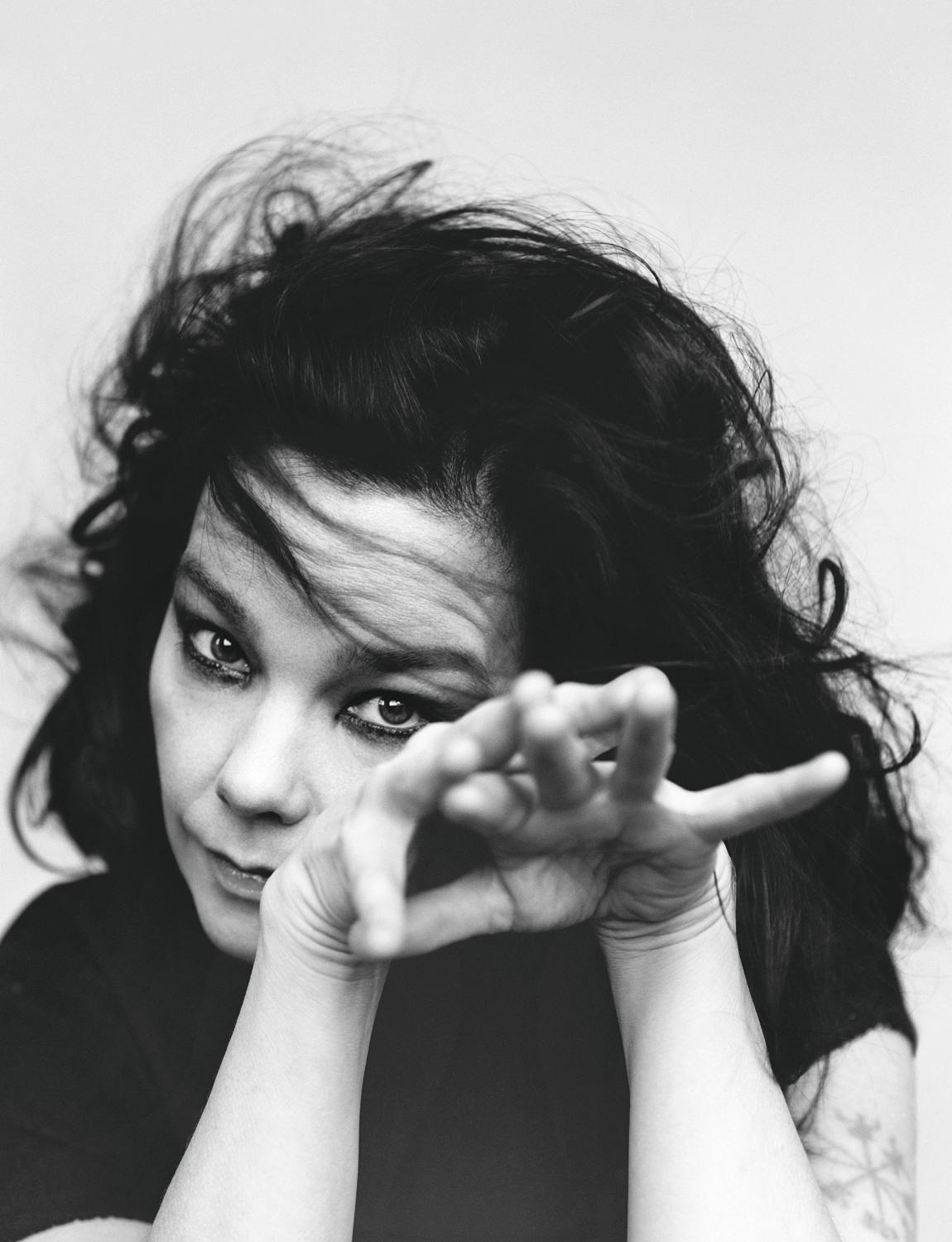
There’s still a lot to do, and Björk will be going to New York soon to work on the show. That’s where she usually spends the winter anyway – for the last six years, when not travelling to perform, she’s lived in Iceland from July to December, then spent January to June in New York, where her 12-year-old daughter with Barney, Ísadóra Bjarkardóttir Barney, attends a progressive, art-focused school in Brooklyn. At first, the family lived outside the city, near a park where Björk could walk during the day to compose her songs. They also tried living on a boat moored on the east side of Manhattan. “We found that summers were amazing on the boat, but winter was harsh for the kid. And our daughter needs to go to school, so it was like, ‘Hmm, are we going to school her from the boat?’” Her new apartment is down the street from her daughter’s school. “I had no idea what kind of neighbourhood it was, because I’m a clueless Icelandic person,” she says. “It’s a kind of granny, posh area, which is sweet. It has old restaurants and second-hand bookstores. And to be honest, it’s nice for me to be where I can go in my pyjamas and” – she throws her hair in front of her face, to demonstrate what it looks like in the morning – “to get milk, and no one has a clue who I am. I couldn’t live in Williamsburg. I’d be fucked.”
It took time for her to get settled in America. “I have a complicated relationship with New York,” she says. “It took me forever to learn how to get around, and I get really claustrophobic. I love cities for two weeks. ‘Whoo-hoo! Let’s go to concerts every night, and openings and bookshops and burger shops!’ Then after two weeks I want to get out. I’m like a wild animal.” But now, she says, “I have ten friends who I can really talk to in New York. I feel that if you have that, you can function as a human.”
After putting on a puffy white jacket shaped like a cape, she jumps in the car you’d imagine Björk driving: an old white Land Rover, very chic, with lots of throat lozenges strewn around and a pair of oversized purple sunglasses stuffed in the glovebox. A CD case for a Dr. Seuss audio book sits in the front console, and one for the first Destiny’s Child album has been flung on the back seat. Long-legged Merry has been the last to drive the car, and Björk pulls the seat forward as far as it goes. She likes to sit so that she’s almost at the windshield. Then she throws the car in reverse and peels out of the driveway, emitting what seems like an involuntary sound of absolute glee.
Björk drives very, very fast. Speeding through the neighbourhood next to her own, she says, “Literally 30 of my childhood friends live within five blocks of here with their families – it used to be a grimy area, but now the artists are here.” Soon, she pulls onto a wharf, slipping into a spot in front of a recording studio. In the lobby, she bumps into Siggi Baldursson from the Sugarcubes. “I’ll see you at the annual Bad Taste party on Thursday,” she says, giggling.
Arca is standing outside the studio in an all-black outfit that includes a kilt. Inside, a humidifier blows out lazy puffs of steam in a corner, and the ceiling is insulated with a pattern that looks like a series of icicles. “Alejandro approached me and wanted to work with me, and I don’t want to brag, but I didn’t get few requests,” Björk says. “I told him it was perfect timing, because I needed to do something crazy then, and he should come to Iceland. And it was just magic. It was like falling in love, on a totally platonic, musical level. He knows all my old stuff ten times better than I do – he’d been brought up on my music in Venezuela.” Björk usually makes about half her own beats, but because of the “emergency you go through during heartbreak, I had the typical ten heartbreak songs that were just vocals with string arrangements,” she says. “It was like I was a typical singer-songwriter, with my little guitar and heartbreak songs. I was poking at these delicate, sad songs with a long stick, and I didn’t know what to do with them – they were like a raw, open wound beating on the table.”
Three of her friends are here at the studio too, standing in a cluster, and she greets them warmly. Earlier, I asked her if she’d played the album for Barney, and she said no; she wasn’t sure if she would before it was released. Will she get married again? “I don’t really know,” she says. “I just don’t. I’ve always felt that I know more about myself in relation to my music. The love stuff is the unknown stuff. It’s not really in your hands and not something you can control much. I’ve always felt that. And sometimes I feel a lot that way, like right now.”
Vanessa GrigoriadisAs a contributing editor to Vanity Fair, New York and Rolling Stone magazines, Vanessa Grigoriadis has established herself as the mistress of long-form journalism; the prima donna of profiles, the maestra of pop culture. Karl Lagerfeld, Britney Spears, Justin Bieber and, notoriously, Gwyneth Paltrow…read more Portraits by
Alasdair McLellanOne of the leading fashion photographers working today, Alasdair McLellan is noted for his warm, intelligent portraiture, which has featured in Fantastic Man, Self Service, multiple Vogues and Love, among many other quality titles. Originally from Doncaster, Alasdair is a fan of 1980s super-producers…read more Styling by
Jonathan KayeJonathan Kaye is fashion director of The Gentlewoman. A graduate of Central St. Martins' prestigious MA Fashion course (the good ones often are), Jonathan is one of the most industrious stylists in the business and thus operates on a “strictly no parties” basis. He has collaborated with photographers…read more
Hair: Shon at Julian Watson Agency. Make-up: Lisa Butler at The Collective Shift. Manicure: Jenny Longworth. Photographic assistance: Lex Kembery, James Robjant, Matthew Healy. Styling assistance: Max Ortega Govela. Hair assistance: Ryuta Saiga. Make-up assistance: Rachel Singer-Clark. Tailor: Alison O’Brien. Production: Ragi Dholakia Productions.
This profile was originally published in The Gentlewoman n° 11, Spring & Summer 2015.